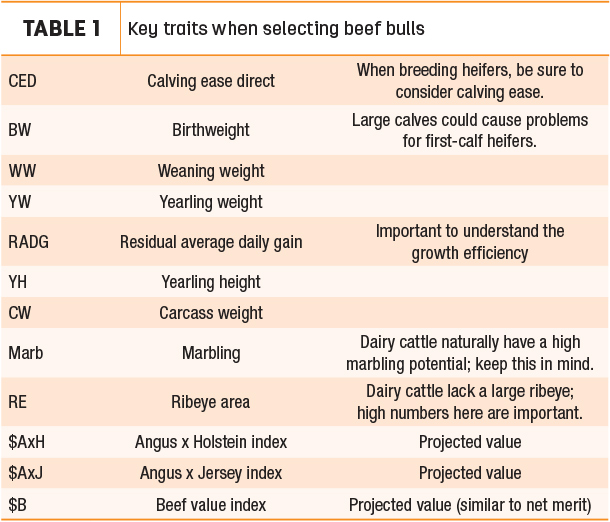As milk prices continue to waver, dairy producers across the country are looking down different avenues for profit. One that seems to be growing in popularity is the practice of breeding the bottom end of a herd with beef semen and selling the crossbred calves at a higher market value.
The driving force behind using beef semen on the bottom end of the herd is to capitalize on replacement inventories. With the increased use of sexed dairy semen across the board, the heifer population is skyrocketing, resulting in a surplus. Using beef semen lowers the number of replacements produced annually.
As genomic testing has advanced, dairy producers can determine which heifers will be profitable as cows. With this knowledge, bottom-end heifers are bred to beef semen, producing a crossbred calf of higher value than a traditional dairy bull. This practice also raises the genetic value of the high-producing end of the herd, as the low-producing sector’s genetics are terminated with the use of beef semen.
Penn State Extension hosted a webinar with associates Robert Goodling Jr. and Andrew Sandeen discussing considerations that should be made before using beef semen in your herd.
Goodling, a Penn State graduate with a master’s in dairy science from the University of Wisconsin – Madison, suggested asking these questions before implementing this practice:
1. What are the goals for this herd?
- Are you looking to improve the genetics of the top end?
- Are you looking to eliminate the surplus of heifers?
- Is this a current or a future problem or goal?
Have a significant understanding of the availability of heifers, raising costs, cow flow dynamics, feed costs and availability, and sale prices for the specific operation.
“Think about how this decision relates to the cash flow or mechanics of your dairy operation,” Goodling said. “It really comes down to reproductive management, more specifically, our cull rate and our heifer program.” According to Albert DeVries at the University of Florida, the ideal cull rate is around 20%-25%. The U.S. average, as of November 2020, is around 38%.
Determining the ratio between animals leaving the herd and animals joining is essential in deciding if you have a surplus in heifers, or if it just appears that way. “Knowing what you have is critical when considering using beef in your herd,” Goodling said. “Remember that you’re still two years from seeing a profit from this management decision; it’s a long-term thing. Don’t put all your eggs in one basket because we don’t know what the future brings.”
2. Which animals should be bred to beef?
“I want to preface this question by saying that it depends,” said Sandeen, a graduate of Ohio State with a master’s in animal science. “Each farm is unique; each herd is different. There’s no right or wrong answer to this question; it purely depends on your situation.”
In 2019, a study was conducted at UW – Madison by Victor Cabrera and Wen Li that explored the optimal combination of sexed-dairy and conventional-beef semen in several herds. In a herd with a pregnancy rate of 30%, they found that using no sexed semen and using beef semen on the bottom 50% of the herd was the most cost-effective method. Herds with around a 20% pregnancy rate found success by using sexed semen on the first service in heifers and beef semen on the bottom 50%. Herds with a 15% or lower pregnancy rate implemented the use of sexed semen on the first and second service in heifers and 20% of cows, while using beef semen on the bottom 25%.
Sandeen warns that using beef semen is not a solution for problem cows. “Use the genetic information that’s available to determine what to use beef on, like PTA [predicted transmitting ability] or parent average,” Sandeen said. “Oftentimes, we think that we should target the cows with high somatic cell or low pregnancy rates, but simply using beef semen will not solve those problems.”
A survey conducted in 2019 by Bill Halfman and Ryan Sterry of UW – Madison asked dairymen from Wisconsin, Iowa and Michigan how they decide to breed cows with beef semen. The top reason was poor reproduction, followed by milk production, conformation, PTA and/or parent average and genomic makeup.
“Though this study might show the opposite, I would again encourage you to base the decision to use beef on genetics, not problems,” Sandeen advised.
3. Which breed should I use?
Angus is the most popular breed being used in dairy herds, but there are several breeds to consider. “We don’t want to say that any Angus bull would do the trick,” Sandeen said. “We can do better than that.”
Doing some homework on beef bulls can make you more money than simply using the cheapest semen. Five popular breeds being used on dairy herds include Black Angus, Lim-Flex, Limousin, SimAngus and Simmental.
4. Which bulls should I use?
Beef proofs are structured slightly differently than dairy proofs, and it’s important to know what you’re looking at. Sandeen briefly discussed some key traits that should be considered when selecting beef bulls (Table 1).

5. What are buyers looking for?
Depending on if you’re sending crossbred calves to a feedlot or a slaughterhouse, buyer preferences can vary. Collectively, however, buyers are looking for consistently healthy animals with natural marbling.
“It’s extremely important to buyers that these crossbred bull calves are getting the same care that heifers would be getting,” Sandeen said. “We put a lot of effort into heifer care; buyers want that same effort put into these crossbreds.”
Approaching this venture with an open mind could make all the difference.
“Having a good relationship with your local beef industry is important in understanding how to properly market your crossbreds,” Goodling said. “We kind of have to switch hats from thinking like a dairy producer to thinking like a beef producer and understanding your market, understanding where those values can be placed. What do they want? What are they looking for? What are they interested in having?
“… we can’t think that ‘Oh we’ll give this surplus to the beef industry and they can deal with it.’ That’s not the right mentality to have. We need to listen to them and provide some of the products that they want so that both industries are benefitting.”






